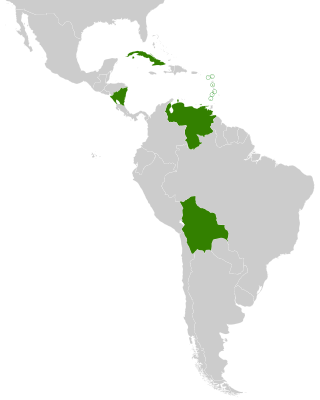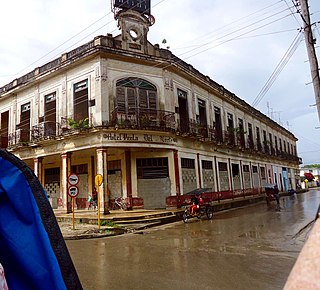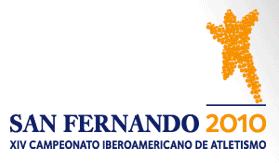Related Research Articles

The Organization of American States is an international organization that was founded on 30 April 1948 for the purposes of solidarity and co-operation among its member states within the Americas. Headquartered in the United States capital, Washington, D.C., the OAS has 35 members, which are independent states in the Americas. Since the 1990s, the organization has focused on election monitoring. The Secretary General of the OAS is Uruguayan Luis Almagro.

La Paz, officially known as Nuestra Señora de La Paz, is the seat of government of the Plurinational State of Bolivia. With an estimated 816,044 residents as of 2020, La Paz is the third-most populous city in Bolivia. Its metropolitan area, which is formed by La Paz, El Alto, Achocalla, Viacha, and Mecapaca makes up the second most populous urban area in Bolivia, with a population of 2.0 million, after Santa Cruz de la Sierra with a population of 2.3 million. It is also the capital of the La Paz Department.

Sucre is the capital of Bolivia, the capital of the Chuquisaca Department and the sixth most populous city in Bolivia. Located in the south-central part of the country, Sucre lies at an elevation of 2,810 m (9,220 ft). This relatively high altitude gives the city a subtropical highland climate with cool temperatures year-round.
Latin America contains approximately 17.5% of the world's Quakers. Latin American Friends are concentrated in Bolivia and Central America. Most of these Friends are evangelical and are affiliated with Evangelical Friends Church International. Friends World Committee for Consultation organizes among them through the Comité de Amigos Latinoamericanos CoAL del Comité Mundial de Consulta de Los Amigos CMCA FWCC.
The Communist Party of Bolivia is a communist party in Bolivia. It was founded in 1950 by Raúl Ruiz González and other former members of the Revolutionary Left Party (PIR). It remained small and did not hold its first national party congress until 1959.
Corps General Abelardo Colomé Ibarra was a Vice President of the Council of State of Cuba and the Cuban Minister of the Interior, serving in the latter position from 1989, until his retirement in October, 2015. Known as Furry he first laid the foundations of State Security in 1959.

ALBA or ALBA–TCP, formally the Bolivarian Alliance for the Peoples of Our America or the Bolivarian Alliance for the Peoples of Our America – Peoples' Trade Treaty, is an intergovernmental organization based on the idea of political and economic integration of Latin American and Caribbean countries.

Morón is a city and a municipality in Ciego de Ávila Province in central Cuba. It is one of ten municipalities in the province, and is the second in importance and the oldest. Morón is the closest city to the tourist resorts on Cayo Coco and Cayo Guillermo.

Sandino is a municipality and town in the Pinar del Río Province of Cuba. The town is located close to the coast and as such, fishing is the main economic resource of this place. It is also the gateway to the Guanahacabibes Peninsula, a UNESCO Biosphere Reserve.

The Che Guevara Mausoleum is a memorial in Santa Clara, Cuba, located in "Plaza Che Guevara". It houses the remains of the revolutionary Ernesto "Che" Guevara and twenty-nine of his fellow combatants killed in 1967 during Guevara's attempt to spur an armed uprising in Bolivia. The full area, which contains a bronze 22-foot statue of Guevara, is referred to as the Ernesto Guevara Sculptural Complex.

Bolivia is a municipality and town in the Ciego de Ávila Province of Cuba. It is located in the north-eastern part of the province, bordering the Bay of Jiguey and Cayo Romano.

Primero de Enero is a municipality and town in the Ciego de Ávila Province, Cuba. Originally named Violeta, its name means "1st of January" in Spanish, and is referred to the final day of Cuban Revolution.

Ernesto "Che" Guevara was an Argentine Marxist revolutionary. A major figure of the Cuban Revolution, his stylized visage has become a ubiquitous countercultural symbol of rebellion and global insignia in popular culture.

Taraco Municipality is the seventh municipal section of the Ingavi Province in the La Paz Department, Bolivia. Most of its area is situated on Taraco Peninsula jutting into Lake Wiñaymarka, the southern branch of Lake Titicaca. Its seat is Taraco.

The 2010 Ibero-American Championships in Athletics was an athletics competition which was held at the Estadio Municipal Bahía Sur in San Fernando, Cádiz, Spain from 4–6 June. A total of 44 events were contested, of which 22 by male and 22 by female athletes. A total of 459 athletes from 29 nations participated in the championships. Twelve championships records were set at the fourteenth edition of the competition.
Óscar Daniel Zamora Medinaceli was a Bolivian politician and lawyer. A communist student activist in his youth and leader of a failed Maoist insurgency in the 1970s, Zamora Medinaceli went on to become a senator, minister, mayor, ambassador and prefect.

Bolivia–Cuba relations refers to the diplomatic relations between Bolivia and Cuba. Both nations are members of the United Nations, but relations of Bolivia with Cuba, like those of most countries in the Western Hemisphere with the notable exceptions of Canada and Mexico, have waxed and waned over the decades depending on geopolitical and regional political circumstances. Relations were good under Evo Morales, who shared the position of his like-minded left-wing allies in Nicaragua and Venezuela that Fidel Castro was a humanist and beloved icon of resistance to US hegemony in Latin America.
Luis Marín is a Cuban Neo-expressionist painter and visual artist. He has been active internationally in the arts since the 1980s and is featured in the permanent collections of several prominent fine art institutions including the Museum of Latin American Art and Museum of Art Fort Lauderdale.
References
- ↑ "Museo Municipal de Bolivia". Portal del Consejo Nacional de Patrimonio Cultural. Retrieved 2015-11-01.